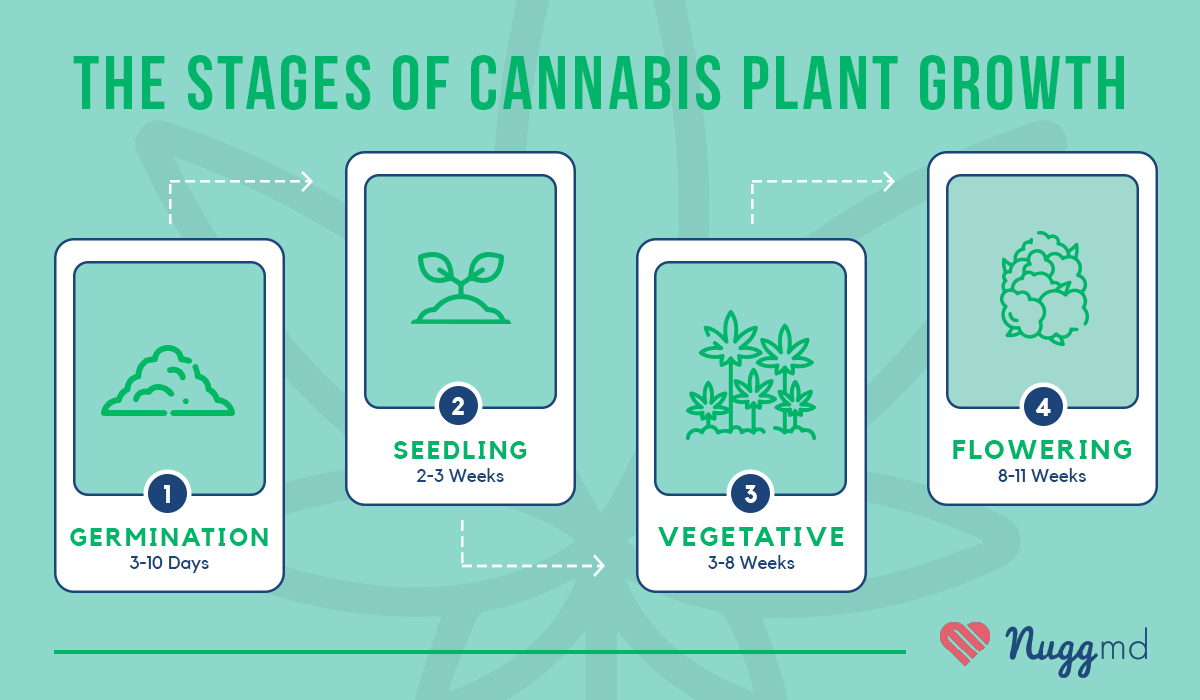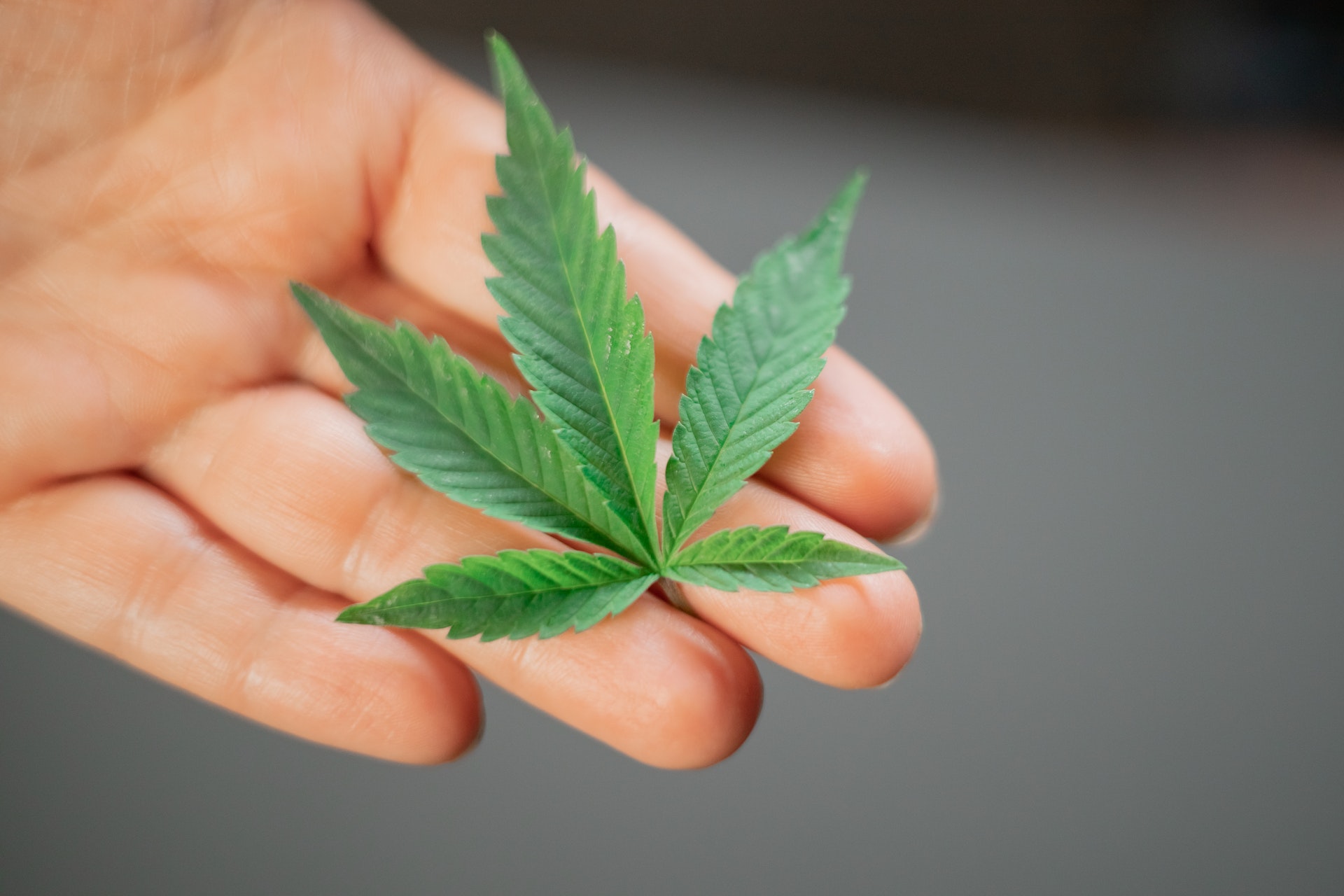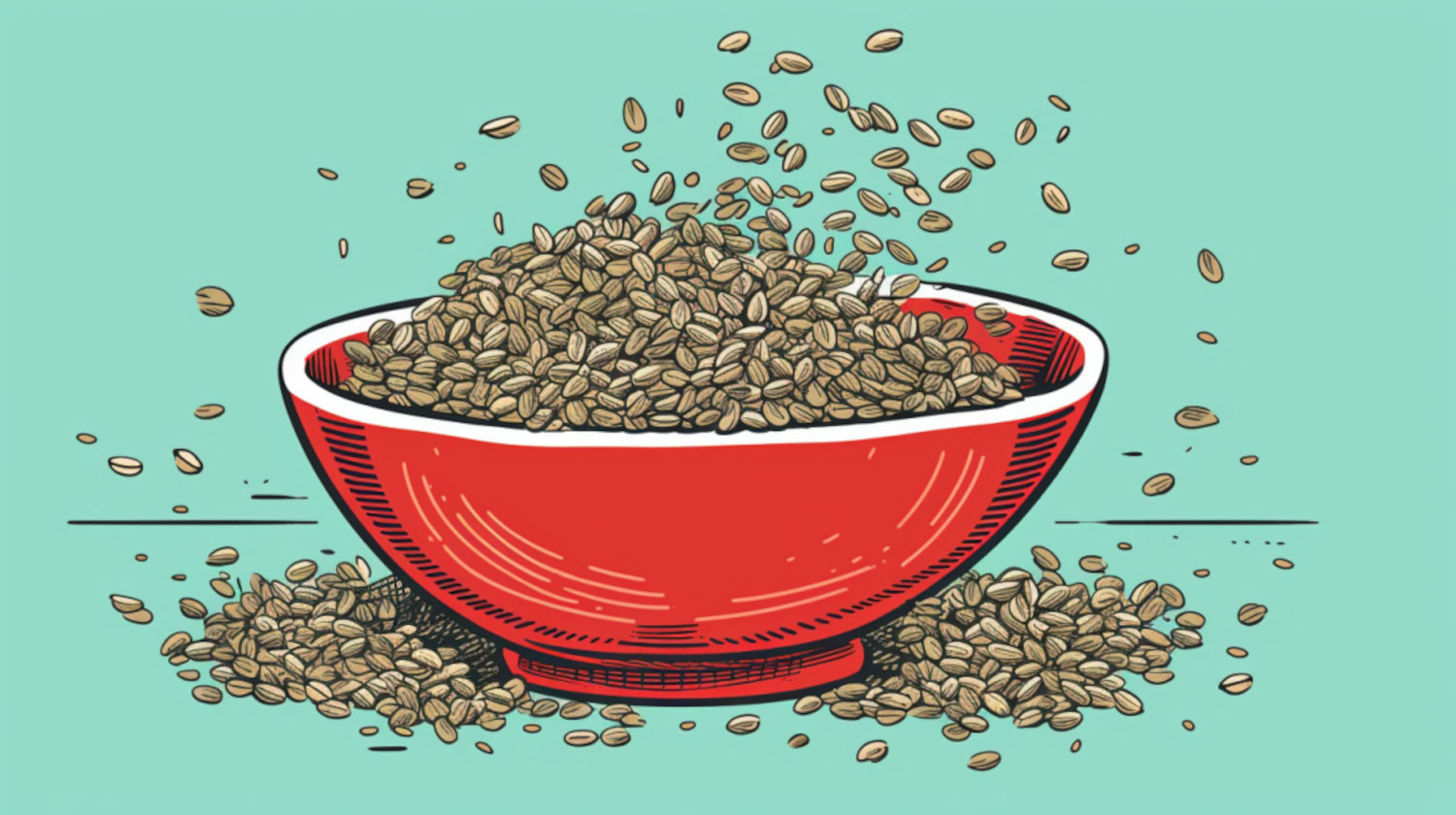Cannabis plants go through several stages of growth before they mature and produce the intoxicating buds that everyone is after. Knowing how to navigate these stages will allow you to grow your own cannabis at home, saving you money while giving you access to your favorite strains year-round.
This article examines the four stages of weed growth and how to provide proper care at each step for successful cultivation.
The 4 Stages of Growing Weed

There are 4 primary stages of growing weed. These are:
- Germination
- Seedling
- Vegetative
- Flowering
Let's take a closer look at each.
1. Germination
Length of Stage: 3-10 days.
Necessary Light Cycle: 18 hours/day for indoor plants; 6 hours/day for outdoor plants.
As is the case for most plants, cannabis starts its growth cycle as a humble seed.
Once a cannabis seed has fully developed and is capable of germination, it will be dry, hard, and brown in color, often having “tiger stripes.”
If the seed isn't fully developed (and incapable of germination), it'll be green or white, wet, and soft. These seeds won’t work in your home grow and should be thrown away.
The process of germinating cannabis seeds is the same as that of other plant seeds. All you need to do is place the seed somewhere wet and dark and give it some time.
Many cannabis growers use a damp paper towel or a cup of water to germinate their seeds.
It will take a little while for leaves to emerge from these seeds - typically, germination only takes a few days. Once the leaves begin to appear, you must place the plant in a growing medium, such as soil, perlite, or Coco Coir. Soon after, two cotyledons (the seed leaves within a seed's embryo) will continue growing out from the seed's casing.
As roots develop, the stalk will rise, and you'll begin to see the first iconic fan leaves; at this point, your cannabis plant can be considered a seedling, and the next stage of growing weed begins.
2. Seedling
Length of Stage: 2-3 weeks.
Necessary Light Cycle: 18 hours/day for indoor plants; 6 hours/day for outdoor plants.
At first, the leaves on the sprout will only have a single blade. However, once the Seedling stage has begun, more blades will grow and develop into the famous cannabis fan leaves that so many growers and consumers are familiar with.
Your new cannabis plant is considered a seedling until it has developed the total number of blades on each of its fan leaves. Typically, this means 5 - 7 on every leaf (but your plant could grow even more).
During the seedling stage, the roots of your cannabis plant are tiny. As a result, it can be easy to overwater your freshly sprouted seedlings and kill them. So be careful and conservative while watering.
Not only are seedlings prone to overwatering, but they are also susceptible to developing mold. As such, you'll need to be mindful of keeping the growing environment clean and keep track of the humidity.
Because of how fragile cannabis plants are during the seedling stage, many cultivators grow their seedlings indoors under artificial lights, even if they are destined to become outdoor plants, as the conditions of the growing environment are easier to control and monitor.
3. Vegetative
Length of Stage: 3-16 weeks
Necessary Light Cycle: 18 hours/day for indoor plants; 6 hours/day for outdoor plants.
Once your seedling has grown the complete number of blades on its fan leaves, the vegetative stage of growing weed has started.
This stage, which lasts from a few weeks to several months, is where the bulk of the plant growth happens.
It is also one of the most exciting phases, considering this growth happens very rapidly. You'll see your plants quickly grow in size and foliage each day.
This stage is also when pruning your cannabis plants comes into play (more on that later).
When growing cannabis plants, you'll need to separate or discard the male plants during the vegetative stage. Otherwise, they will pollinate the female plants and ruin your potential flower yields. Learn more about how to tell the difference between male and female cannabis plants.
Healthy cannabis plants will need plenty of water and nutrients during this stage, especially nitrogen.
The vegetative stage ends as soon as the plants start developing buds.
4. Flowering
Length of Stage: 8-11 weeks
Necessary Light Cycle: 12-13 hours/day for indoor plants; 6 hours/day for outdoor plants.
The final marijuana growth stage is the flowering stage.
As we mentioned, this is when your cannabis plant begins to develop and grow buds that'll be dried and cured and eventually consumed by you or others.
Typically, most cannabis plants will only take 8 - 10 weeks to finish flowering. However, certain strains may need more time to develop fully.
The flowering stage naturally coincides with the reduced amount of daily sunlight at this point in the growing season, when summer gives way to autumn.
If you're growing your marijuana plants indoors, you'll need to intentionally reduce the amount of light your plants are getting to start the flowering stage.
Within the flowering stage, there are three distinct sub-stages to look out for:
- Initial flowering: Within the first few weeks of the flowering stage, female cannabis plants will start growing the beginnings of buds. You'll notice the development of pistils, which look like white hairs, growing on your cannabis plants.
- Mid flowering: Within 4 - 6 weeks of the initial flowering, your marijuana plant will not grow any taller, but the buds will begin to fully develop and continuously grow larger.
- Final ripening: Approximately 6 - 8 weeks after the flowering stage begins, your cannabis plants will begin to ripen. This means that the density of trichomes in the bud will increase and be close to harvesting time.
During the final ripening phase of the flowering stage, your plant’s trichomes should be white and milky. If you touch your buds, they'll likely be very sticky, which means that your buds are packed with THC.
That said, your plants are likely ready for harvesting at this point. However, if you wait another week or two, you'll notice that the trichomes on your plants change from white to amber. If this happens, the THC in your cannabis is beginning to break down. If this is the case, you should immediately harvest your plants to preserve as much THC in your bud as possible.
Post-Flowering Stage

Once your cannabis plants have gone through the above four stages, they'll be fully grown.
Here's what you need to do now in the post-flowering stage:
When you harvest your cannabis plants, divide the whole plant into several smaller branches. This helps speed up the drying process later on.
Use a strong string or cord to hang these branches upside down (and above the floor) in a dark room that isn't too hot or humid.
The drying stage should last at least 1 - 2 weeks. This is a crucial part of harvesting weed for several reasons. First and foremost, freshly harvested cannabis will likely be too wet to smoke. Second, drying weed helps prevent mold from growing on your cannabis crop and ruining all your hard work.
After the crop has been dried, you'll need to trim all the nugs off the plant stems. This can often be the most time-consuming and labor-intensive aspect of cultivating cannabis.
Once all the nugs have been collected from the plant branches and stems, you can decide whether to cure your weed or not.
"Curing" weed refers to sealing cannabis within airtight containers such as glass jars and allowing it to age for 1 - 3 weeks. Then, once a day, you'll open up the container, allowing your weed to absorb the fresh air.
Truth be told, this is an optional part of growing weed. Your cannabis will be fine to consume if you decide not to cure it after drying. Still, it's thought that this process can help improve your yield's flavor and overall quality.
Storing
After your cannabis plants have been harvested, dried, trimmed, and cured, you'll be done! Congratulations, you've grown your own bud!
Now, you'll need to store it properly if you expect it to last.
Here's how to do just that:
✔ Store Your Weed in an Airtight Container
If you decide to cure your weed, you're already on the right track regarding storage. Proper containers for curing, such as a mason jar, are also perfect for storing weed long-term.
Ultimately, anything that is airtight will do. Otherwise, you risk your crop drying out much faster than it otherwise would.
✔ Keep Cannabis Stored in a Cool, Dry, and Dark Place
Keep your airtight cannabis containers somewhere cool, dry, and dark.
Excess temperature, moisture, and direct sunlight can all negatively impact the quality of your weed. Direct sunlight, especially, can quickly destroy the THC you worked so hard to cultivate.
Storing your cannabis somewhere too hot can also be a problem. Temperature, especially combined with moisture, can quickly lead to mold development and flower that may be unsafe for consumption.
✔ Keep an Eye on the Humidity
Humidity is another essential factor to pay attention to when storing cannabis. If the storage conditions are too humid, you increase the likelihood that your cannabis will start becoming moldy. You should strive to keep the humidity between 55 - 62% as much as possible.
Luckily, there are many products you can use to help maintain this ideal range, such as weed humidity packs and cannabis humidor boxes.
✔ Pruning
It's recommended that you prune your plants during the vegetative growth stage. Doing so will ensure your plants remain healthy and yield as big as possible.
It's best to wait until your plants are at least a foot tall with several leaves before you begin pruning. The less you prune, the bushier and stockier your plants will be.
However, you should avoid pruning your plants outside the vegetative stage, especially if they are flowering. If you aren’t careful, heavily pruning your plants as they mature can potentially delay or even prevent their flowering.
Practical Tips for a High-Quality Harvest
There are two ways you can potentially trim and harvest your weed.
- Dry trimming
- Wet trimming
The most common method among cannabis cultivators is dry trimming, which involves chopping down the plants and hanging them for several days to dry. You can also try wet trimming, which skips the drying step and jumps right into trimming the nugs.
Here are some helpful tips to ensure a high-quality harvest:
- Do not feed them any nutrients a week or so before you are scheduled to chop your plants. Just use water.
- Look at the trichomes on the nugs to determine when the plant is ready to be harvested. They should look like dew on grass. If they begin to turn yellowish or brownish, your plants should have been harvested already, and you should do so immediately.
- When you're harvesting, wear clothes you don't mind getting dirty.
- Trimming weed can be laborious and time-consuming. Make sure your scissors are sharp to make things easier for you.
- If you're cultivating several different strains, be mindful that they may need to be harvested at separate times.
If you want to grow cannabis plants as quickly as possible, you can skip the germination and seedling stages by using clones. A clone is a cutting from a living plant that will grow into its own plant, giving new patients an easy way to start their home grow.
And there you have it! Every cultivator will experience the four stages of growing weed. Check the links below for more information on how to help your home grow and thrive so you can get bigger and better nugs.
Happy growing!
The information in this article and any included images or charts are for educational purposes only. This information is neither a substitute for, nor does it replace, professional legal advice or medical advice, diagnosis, or treatment. If you have any concerns or questions about laws, regulations, or your health, you should always consult with an attorney, physician or other licensed professional.




